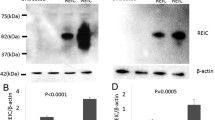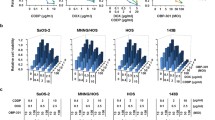Abstract
Purpose
MYCN amplification and p53 inactivation are two typical characteristics of aggressive neuroblastomas and are strongly associated with cancer progression and treatment failure. In an effort to develop new therapeutic agents to treat the aggressive neuroblastomas, we constructed ZD55-shMYCN, an oncolytic adenovirus ZD55 carrying short hairpin RNA (shRNA) targeting MYCN gene, and investigated the effects on proliferation of the p53-null and MYCN-amplified neuroblastoma cell line LA1-55N in vitro and in vivo by ZD55-shMYCN.
Methods
In this study, we used ZD55-shMYCN to treat p53-null and MYCN-amplified neuroblastoma cells. To confirm the ability of selective replication of the ZD55-shMYCN, we examined the expression of E1A protein by western blotting. We used quantitative real-time PCR analysis and western blotting analysis to determine the inhibitory effect of ZD55-shMYCN on MYCN expression. MTT [3-(4,5-dimethylthiazol-2-yl)-2,5-diphenyltetrazolium bromide] cell proliferation assay and xenograft mouse model were used to test the antigrowth efficacy of ZD55-shMYCN.
Results
The results showed that ZD55-shMYCN selectively replicated and significantly downregulated the MYCN expression in LA1-55N cells. ZD55-shMYCN effectively inhibited the proliferation in LA1-55N cells in vitro and significantly inhibited tumor growth in vivo xenograft tumor in nude mice.
Conclusions
ZD55-shMYCN provides a novel agent for treating MYCN-amplified and p53-inactive aggressive neuroblastoma, representing a promising approach for further clinical development.





Similar content being viewed by others
References
Au T, Thorne S, Korn WM, Sze D, Kirn D, Reid TR (2007) Minimal hepatic toxicity of Onyx-015: spatial restriction of coxsackie-adenoviral receptor in normal liver. Cancer Gene Ther 14(2):139–150. doi:10.1038/sj.cgt.7700988
Chesler L, Goldenberg DD, Collins R, Grimmer M, Kim GE, Tihan T, Nguyen K, Yakovenko S, Matthay KK, Weiss WA (2008) Chemotherapy-induced apoptosis in a transgenic model of neuroblastoma proceeds through p53 induction. Neoplasia 10(11):1268–1274
Feng C, Wang T, Tang R, Wang J, Long H, Gao X, Tang S (2010) Silencing of the MYCN gene by siRNA delivered by folate receptor-targeted liposomes in LA-N-5 cells. Pediatr Surg Int 26(12):1185–1191. doi:10.1007/s00383-010-2703-5
Garcia-Castro J, Alemany R, Cascallo M, Martinez-Quintanilla J, Arriero Mdel M, Lassaletta A, Madero L, Ramirez M (2010) Treatment of metastatic neuroblastoma with systemic oncolytic virotherapy delivered by autologous mesenchymal stem cells: an exploratory study. Cancer Gene Ther 17(7):476–483. doi:10.1038/cgt.2010.4
Guse K, Hemminki A (2009) Cancer gene therapy with oncolytic adenoviruses. J BUON Official J Balkan Union Oncol 14(Suppl 1):S7–15
Hara J (2012) Development of treatment strategies for advanced neuroblastoma. Int J Clin Oncol/Jpn Soci Clin Oncol. doi:10.1007/s10147-012-0417-5
Henderson TO, Bhatia S, Pinto N, London WB, McGrady P, Crotty C, Sun CL, Cohn SL (2011) Racial and ethnic disparities in risk and survival in children with neuroblastoma: a Children’s Oncology Group study. J Clin Oncol Official J Am Soc Clin Oncol 29(1):76–82. doi:10.1200/JCO.2010.29.6103
Jiang R, Xue S, Jin Z (2011) Stable knockdown of MYCN by lentivirus-based RNAi inhibits human neuroblastoma cells growth in vitro and in vivo. Biochem Biophys Res Commun 410(2):364–370. doi:10.1016/j.bbrc.2011.06.020
Kang JH, Rychahou PG, Ishola TA, Qiao J, Evers BM, Chung DH (2006) MYCN silencing induces differentiation and apoptosis in human neuroblastoma cells. Biochem Biophys Res Commun 351(1):192–197. doi:10.1016/j.bbrc.2006.10.020
Keshelava N, Zuo JJ, Chen P, Waidyaratne SN, Luna MC, Gomer CJ, Triche TJ, Reynolds CP (2001) Loss of p53 function confers high-level multidrug resistance in neuroblastoma cell lines. Cancer Res 61(16):6185–6193
Kroesen M, Lindau D, Hoogerbrugge P, Adema GJ (2012) Immunocombination therapy for high-risk neuroblastoma. Immunotherapy 4(2):163–174. doi:10.2217/imt.11.169
Li H, Dutuor A, Tao L, Fu X, Zhang X (2007) Virotherapy with a type 2 herpes simplex virus-derived oncolytic virus induces potent antitumor immunity against neuroblastoma. Clin Cancer Res Official J Am Assoc Cancer Res 13(1):316–322. doi:10.1158/1078-0432.CCR-06-1625
Lu X, Pearson A, Lunec J (2003) The MYCN oncoprotein as a drug development target. Cancer Lett 197(1–2):125–130
Mahller YY, Williams JP, Baird WH, Mitton B, Grossheim J, Saeki Y, Cancelas JA, Ratner N, Cripe TP (2009) Neuroblastoma cell lines contain pluripotent tumor initiating cells that are susceptible to a targeted oncolytic virus. PLoS ONE 4(1):e4235. doi:10.1371/journal.pone.0004235
Maris JM (2010) Recent advances in neuroblastoma. N Engl J Med 362(23):2202–2211. doi:10.1056/NEJMra0804577
Matthay KK, Reynolds CP, Seeger RC, Shimada H, Adkins ES, Haas-Kogan D, Gerbing RB, London WB, Villablanca JG (2009) Long-term results for children with high-risk neuroblastoma treated on a randomized trial of myeloablative therapy followed by 13-cis-retinoic acid: a children’s oncology group study. J Clin Oncol Official J Am Soc Clin Oncol 27(7):1007–1013. doi:10.1200/JCO.2007.13.8925
McCormick F (2003) Cancer-specific viruses and the development of ONYX-015. Cancer Biol Ther 2(4 suppl 1):S157–S160
Nara K, Kusafuka T, Yoneda A, Oue T, Sangkhathat S, Fukuzawa M (2007) Silencing of MYCN by RNA interference induces growth inhibition, apoptotic activity and cell differentiation in a neuroblastoma cell line with MYCN amplification. Int J Oncol 30(5):1189–1196
Navalkele P, O’Dorisio MS, O’Dorisio TM, Zamba GK, Lynch CF (2011) Incidence, survival, and prevalence of neuroendocrine tumors versus neuroblastoma in children and young adults: nine standard SEER registries, 1975–2006. Pediatr Blood Cancer 56(1):50–57. doi:10.1002/pbc.22559
Pearson AD, Pinkerton CR, Lewis IJ, Imeson J, Ellershaw C, Machin D, European Neuroblastoma Study G, Children’s C, Leukaemia G (2008) High-dose rapid and standard induction chemotherapy for patients aged over 1 year with stage 4 neuroblastoma: a randomised trial. Lancet Oncol 9(3):247–256. doi:10.1016/S1470-2045(08)70069-X
Pei DS, Di JH, Chen FF, Zheng JN (2010) Oncolytic-adenovirus-expressed RNA interference for cancer therapy. Expert Opin Biol Ther 10(9):1331–1341. doi:10.1517/14712598.2010.512002
Pesonen S, Helin H, Nokisalmi P, Escutenaire S, Ribacka C, Sarkioja M, Cerullo V, Guse K, Bauerschmitz G, Laasonen L, Kantola T, Ristimaki A, Rajecki M, Oksanen M, Haavisto E, Kanerva A, Joensuu T, Hemminki A (2010) Oncolytic adenovirus treatment of a patient with refractory neuroblastoma. Acta Oncol 49(1):117–119. doi:10.3109/02841860903071369
Ramirez M, Garcia-Castro J, Alemany R (2010) Oncolytic virotherapy for neuroblastoma. Discov Med 10(54):387–393
Rothmann T, Hengstermann A, Whitaker NJ, Scheffner M, zur Hausen H (1998) Replication of ONYX-015, a potential anticancer adenovirus, is independent of p53 status in tumor cells. J Virol 72(12):9470–9478
Schor NF (1999) Neuroblastoma as a neurobiological disease. J Neurooncol 41(2):159–166
Tonini GP, Pistoia V (2006) Molecularly guided therapy of neuroblastoma: a review of different approaches. Curr Pharm Des 12(18):2303–2317
Toyoda H, Yin J, Mueller S, Wimmer E, Cello J (2007) Oncolytic treatment and cure of neuroblastoma by a novel attenuated poliovirus in a novel poliovirus-susceptible animal model. Cancer Res 67(6):2857–2864. doi:10.1158/0008-5472.CAN-06-3713
Van Maerken T, Vandesompele J, Rihani A, De Paepe A, Speleman F (2009) Escape from p53-mediated tumor surveillance in neuroblastoma: switching off the p14(ARF)-MDM2-p53 axis. Cell Death Differ 16(12):1563–1572. doi:10.1038/cdd.2009.138
Weber A, Starke S, Bergmann E, Christiansen H (2006) The coamplification pattern of the MYCN amplicon is an invariable attribute of most MYCN-amplified human neuroblastomas. Clin Cancer Res Off J Am Assoc Cancer Res 12(24):7316–7321. doi:10.1158/1078-0432.CCR-06-0837
Wei N, Fan JK, Gu JF, He LF, Tang WH, Cao X, Liu XY (2009) A double-regulated oncolytic adenovirus with improved safety for adenocarcinoma therapy. Biochem Biophys Res Commun 388(2):234–239. doi:10.1016/j.bbrc.2009.07.142
Westermark UK, Wilhelm M, Frenzel A, Henriksson MA (2011) The MYCN oncogene and differentiation in neuroblastoma. Semin Cancer Biol 21(4):256–266. doi:10.1016/j.semcancer.2011.08.001
Woo CW, Tan F, Cassano H, Lee J, Lee KC, Thiele CJ (2008) Use of RNA interference to elucidate the effect of MYCN on cell cycle in neuroblastoma. Pediatr Blood Cancer 50(2):208–212. doi:10.1002/pbc.21195
Xue C, Haber M, Flemming C, Marshall GM, Lock RB, MacKenzie KL, Gurova KV, Norris MD, Gudkov AV (2007) p53 determines multidrug sensitivity of childhood neuroblastoma. Cancer Res 67(21):10351–10360. doi:10.1158/0008-5472.CAN-06-4345
Zhang ZL, Zou WG, Luo CX, Li BH, Wang JH, Sun LY, Qian QJ, Liu XY (2003) An armed oncolytic adenovirus system, ZD55-gene, demonstrating potent antitumoral efficacy. Cell Res 13(6):481–489. doi:10.1038/sj.cr.7290191
Zheng JN, Pei DS, Sun FH, Zhang BF, Liu XY, Gu JF, Liu YH, Hu XL, Mao LJ, Wen RM, Liu JJ, Li W (2009) Inhibition of renal cancer cell growth by oncolytic adenovirus armed short hairpin RNA targeting hTERT gene. Cancer Biol Ther 8(1):84–91
Acknowledgments
This project was supported by Science and Technology Agency of Xuzhou (No. XF11C087). The funder had no role in study design, data collection and analysis, decision to publish or preparation of the manuscript.
Conflict of interest
The authors have declared that no competing interests exist.
Author information
Authors and Affiliations
Corresponding authors
Rights and permissions
About this article
Cite this article
Li, Y., Zhang, B., Zhang, H. et al. Oncolytic adenovirus armed with shRNA targeting MYCN gene inhibits neuroblastoma cell proliferation and in vivo xenograft tumor growth. J Cancer Res Clin Oncol 139, 933–941 (2013). https://doi.org/10.1007/s00432-013-1406-4
Received:
Accepted:
Published:
Issue Date:
DOI: https://doi.org/10.1007/s00432-013-1406-4




